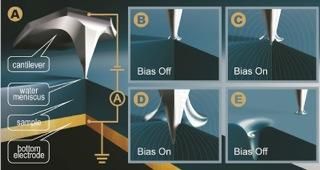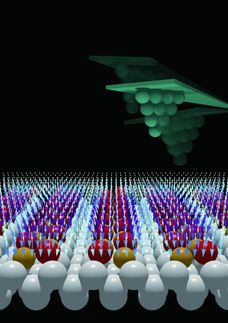ORNL researchers tune friction in ionic solids at the nanoscale
friction impacts motion, hence the need to control friction forces. Currently, this is accomplished by mechanistic means or lubrication, but experiments conducted by researchers at the Department of Energy's Oak Ridge National Laboratory have uncovered a way of controlling friction on ionic surfaces at the nanoscale using electrical stimulation and ambient water vapor.

Researchers used electricity and water to control friction levels on ionic surfaces at the nanoscale. As water forms around the nanoscale electrode, it allows for further penetration into the sample surface, thereby increasing or decreasing friction.
ORNL
The research, which demonstrates a new physical effect, was undertaken at the Center for Nanophase Materials Sciences, a DOE Office of Science User Facility at ORNL, and is published in Scientific Reports.
"Our finding can have a significant technological impact on applications for both macroscopic and nanoscale devices," said lead author Evgheni Strelcov. "Decreasing or increasing nanoscale friction at will and thus controlling mechanical energy losses and wear of a microelectromechanical system's parts has enormous implications for applied energy research and opens a new vista for fundamental science studies."
By inducing a strong electric field using an atomic force microscope, the researchers were able to both increase and decrease friction between a moving nanoscale electrode and an ionic surface. They argue that the primary effect responsible for this behavior is condensation of moisture from the surrounding air into liquid that can then reduce friction.
Simultaneously, further strengthening the electric field results in the nanoscale electrode penetrating the surface and an increase of friction. This penetration is a new and unexpected effect, and the overall approach differs from other methods of friction control that often require adding a lubricant to the system instead of drawing on resources readily available in the immediate environment.
Additionally, unlike other electrochemical friction control practices, the new technique does not require an electrical current, which is associated with energy losses.
"Absence of current is highly beneficial from a power-saving perspective as it eliminates Joule heating and other parasitic power-consuming effects," says Bobby Sumpter, who led the group developing associated theoretical models.
This work builds on extensive efforts at CNMS exploring the electrical manipulation of mechanical, electrochemical and ferroelectric properties of materials.
"We adopted this biased view on the nanoscale almost a decade ago," said contributing author Sergei Kalinin. "Now we can proceed from observation to control of even such sublime phenomena as friction, and it is indeed very surprising and promising that we can both increase and decrease it."
Most read news
Other news from the department science

Get the chemical industry in your inbox
From now on, don't miss a thing: Our newsletter for the chemical industry, analytics, lab technology and process engineering brings you up to date every Tuesday and Thursday. The latest industry news, product highlights and innovations - compact and easy to understand in your inbox. Researched by us so you don't have to.


























































